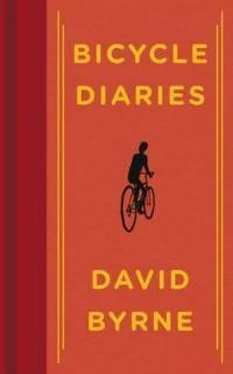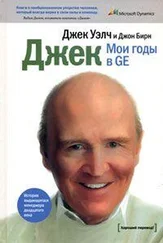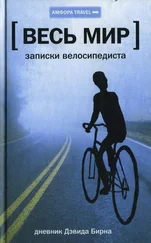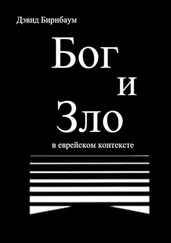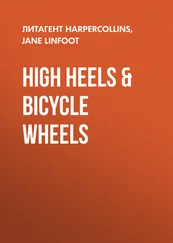The reality in front of me clashes with what I was taught in school. The reality I see says that there isn’t really any difference, that no matter what the ideology the end result is pretty much the same. I’m exaggerating: from a train window or from a bicycle on surface streets I sometimes only see the backsides of everything, which might be unfair.
The train heads out of town. One sees the hind parts of factories. Kudzu. Honeysuckle. Sumac with its fuzzy branches. Chain-link fences. Garbage. Old tires and rusty truck parts. Identical streets of identical row houses—workers’ housing like in a Dickens novel. A billboard announcing “I Love You Baby Doll.” Parking lots and truck yards. Then, suddenly, we’re out of town. Herons skim wetlands and wade in brackish water. East Coast second-growth forests appear—skinny little trees, densely packed.
Detroit
I bike from the center of town out to the suburbs. It’s an amazing ride—a time line through a city’s history, its glory and betrayal. Detroit is not that different from many other cities across the United States, just more dramatic in its ups and downs. In the center of town there is the convention center and the sports arena. There is a shopping district downtown that, like Baltimore’s, has seen much better days—it’s now mostly dirty discount stores selling wigs and cheap imports. There’s a strip of Greek restaurants in an area called Greektown. They smash plates in some of these places, which is fun. Once I leave the central district I begin to encounter some true devastation. As in many similar towns, there are vaguely concentric rings of office zones, industrial zones, low-income housing, businesses, and eventually suburbs. As I leave downtown I find myself riding first through what seems to be the remains of a ghetto, now overgrown and returning to the earth: vast vacant lots, covered over with grasses and some filled with rubble. If you have seen pictures of Berlin after the war, then that’s what this area looks like—desolate, uninhabited. Once in a while there is evidence of some habitation, but mostly it’s a posta- pocalyptic landscape at its finest.
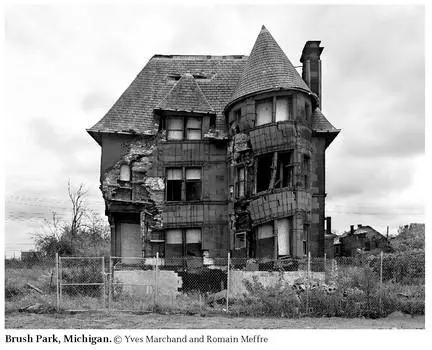
As I ride on I enter a zone of light industry, or former light industry, as most of this area has been abandoned as well. Future condos or artists’ lofts, one might imagine—were this London or Berlin. But poor Detroit seems to have been hit repeatedly, and the likelihood of its recovery seems like a long shot. Though if someone had told me that the most expensive apartment building in New York City would now be a stone’s throw from the Bowery I would have said, “You’re dreaming, and try not to step on that homeless guy sprawled there.”
Miles later—through some funky but at least inhabited neighborhoods—I emerge into the suburbs. There are little “villages” and houses with manicured lawns. I gather that beyond this circle, somewhere near Eminem’s now famous Eight Mile Road, the film begins to run backward; the desolation reappears, though this time the funkiness is more rural—trailer parks and little houses.
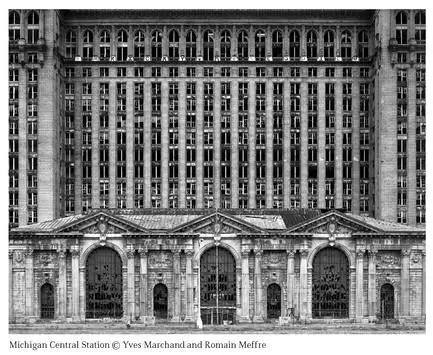
In a way, this was one of the best and most memorable bike rides I’ve ever taken. In a car one would have sought out a freeway, one of the notorious concrete arteries, and would never have seen any of this stuff. Riding for hours right next to it was visceral and heartbreaking—in ways that looking at ancient ruins aren’t. I recommend it.
Sweetwater, Texas
I eat at a restaurant across the highway from the hotel where I’m staying. My steak is delicious—as it should be here. The decor in the restaurant is all red—chairs, tables, and trim—in honor of the local high school football team, the Mustangs. There is a very large painting of the football coach covering the wall behind me. I watch a man across from me shoot up his insulin at his table after he and his wife finish their meal. He does it deftly, as casually as one would look at one’s watch. It’s beautiful.
The restaurant (the only one within walking distance of the hotel, which doesn’t have one) doesn’t serve alcohol. I’m not that surprised. Between the early—for a New Yorker—dinner hours and the many dry counties around here I know we’re not in New York anymore. I enjoy not being in New York. I am under no illusion that my world is in any way better than this world, but still I wonder at how some of these Puritanical restrictions have lingered—the encouragement to go to bed early and the injunction against enjoying a drink with one’s meal. I suspect that drinking, even a glass of wine or two with dinner, is, like drug use, probably considered a sign of moral weakness. The assumption is that there lurks within us a secret desire for pure, sensuous, all-hell-breaking-loose pleasure, which is something to be nipped in the bud, for pragmatic reasons. In a sense maybe loosening up was, for the early settlers, not something to be encouraged, as the farmers and ranchers who settled here had to survive by the skin of their teeth. You never know what will come out of that bottle once you open it. If life is hard, if you’re just getting by, then slipping off that straight and narrow path could have serious consequences. Drinking, therefore, like drug use, becomes relegated to “bad” places—to honky- tonks and dark, sad bars. Either way both druggies and drinkers tend to create their own countercultures. Being ostracized then creates the “bad” scenes that the punishment had hoped to eradicate.
In the local paper a debate is taking place over whether high school students should be subjected to a curfew. It’s not clear what hour is being proposed, but some of the students who aspire to have after-school jobs would certainly not be able to take those jobs if the work hours extended past this proposed curfew. Other students who have after-school sports or other activities would likewise be hamstrung. Many of these students would have to walk home from these jobs or activities, as they are not yet old enough to drive or don’t have their own cars. They would therefore risk being picked up as curfew breakers.
One student quoted in the paper offered that since the local skating rink and some other activities have been closed there is nothing to do in town, so kids, bored out of their minds, will inevitably find something to do, and sometimes it might be disruptive—all that young energy has to go somewhere.
Some students, though, are all in favor of the curfew, as are the local football coaches, who seem to function as the resident wise men around here. I suspect that this proposed curfew could be an unspoken and underhanded way to facilitate and legitimize the rounding up of “loitering” Mexican kids—who are no doubt seen as the principal troublemakers here.
I ride around the older part of town. A motel that was once on the main highway reiterates the moral message: if Jesus never fails, then by implication the problem must be with you.

I wonder if this frontier Puritan fundamentalism, combined with economic pragmatism, is what makes buildings like this minimal one so common, unremarkable, and acceptable out here.
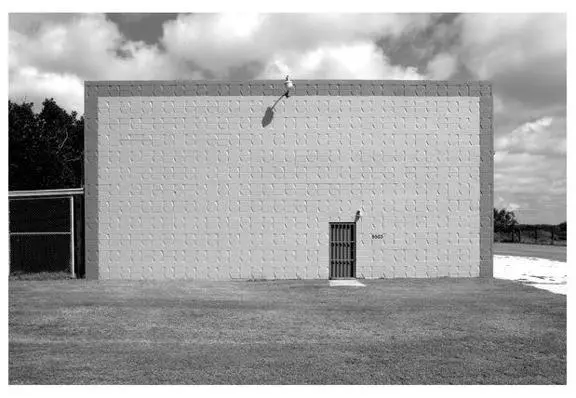
They are beautifully Spartan and purely functional—in their austerity they are in perfect keeping with nineteenth-century architect Louis Sullivan’s dictum “form follows function.” He claimed, “It is the pervading law of all things organic and inorganic, of all things physical and metaphysical.” The implication was that this was not just a style or aesthetic guideline. This was a moral code. This was how God, the supreme architect, works. This humble structure—and many others around here—has followed that dictum to the very end of the line! These structures take the prize: they make the twentieth-century modernists all over the world look positively baroque—and therefore less moral.
Читать дальше
